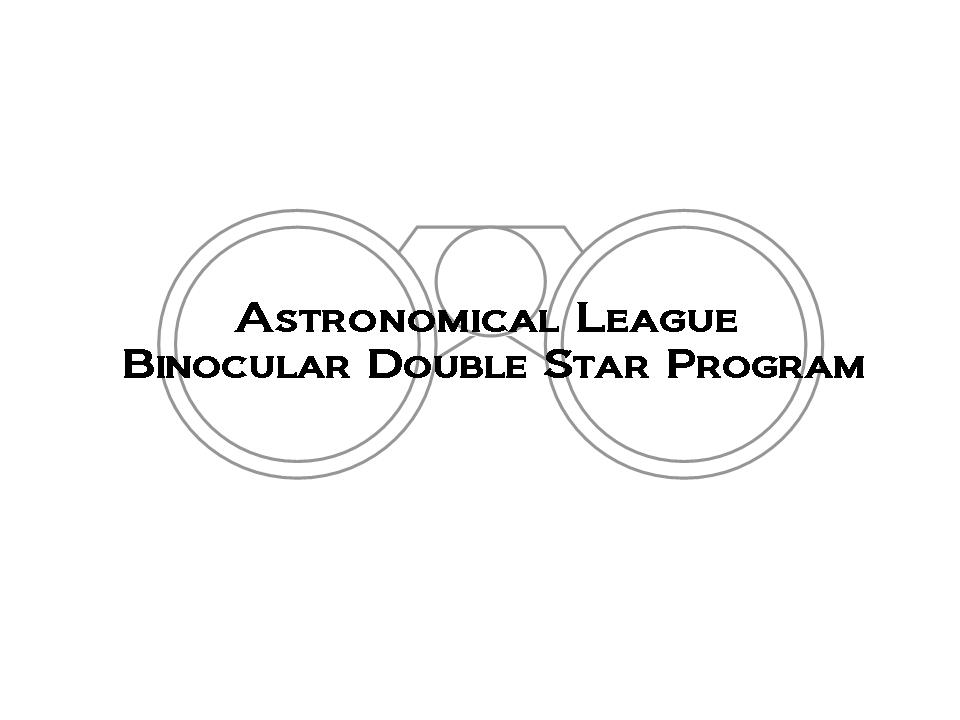Binocular Double Star Observing Program Coordinator:Bob Kerr |
  |
Introduction
Welcome to the Astronomical League’s Binocular Double Star Observing Program. For observers whose primary instruments are binoculars, this will be a rewarding program. Other observers ready to set aside their bulky telescopes for the freedom of viewing the heavens with binoculars will rediscover the wide field glory of the night sky.
This Observing Program takes you on a grand tour. Since double stars are everywhere, your travels will sweep you past blazing suns, dazzling star clusters, glowing nebulae, and distant galaxies. You’ll navigate the dense thickets of the Milky Way and explore the nooks and crannies of the polar constellations.
| This Observing Program is independent of the Double Star Observing Program, which is intended for observation by telescope, and one need not precede or follow the other. Any binocular or combination of binoculars may be used in this program. Several observations combine binocular and naked-eye viewing. This program would complement concurrent observations for the Binocular Messier Observing Program and Deep Sky Binocular Observing Program.
The visual appearance of double stars (used throughout to include multiple stars and star pairs) can be among the most striking in amateur astronomy. This is as true for wide groupings, suitable for viewing with binoculars and by unaided eye, as it is for close, telescopic systems. The varied color combinations, luminosities and separations of these stars never fail to surprise and delight. In this regard, they are well worth observing in their own right. And viewing with both eyes enhances our ability to see dimmer stars and perceive subtle colors. Most observers find that viewing the heavens naturally, with two eyes, lends a depth and clarity unmatched in the telescope eyepiece. |
 |
Another advantage of wide-field double star observing is that we experience these magnificent multiple suns in their relationship to the entire night sky, the constellations and other fascinating celestial objects in their immediate neighborhoods. This may include familiar named stars, asterisms and clusters, other double stars, and nebulae – perhaps viewed in the same binocular field as the double star target. This is also an ideal way to learn about the night sky, its features, and its movements or to reacquaint ourselves with some of our favorite celestial sights. The visual study of double stars has a long and storied tradition, so as you progress through this Observing Program you will experience views first glimpsed and admired by some of astronomy’s greatest observers.
Definition of Binoculars Allowed for Observations
The Astronomical League defines a binocular telescope as an observing device with two optical tubes and two eyepieces, where the eyepieces can be replaced with eyepieces of different focal lengths. “Bino-Viewers” have a single optical tube, but two eyepieces. “Bino-Viewers” and Binocular Telescopes may be used in any Observing Programs that are telescope-based. They may not be used in binocular programs.
Observing devices with two optical tubes and two eyepieces, where you cannot change the eyepieces, are binoculars. Binoculars may be used in any Observing Program requiring telescopes or binoculars. Most binoculars do not have sufficient magnification to replace telescopes.
Requirements and RulesThis certification is available to members of the Astronomical League, either through their local astronomical society or as members at large. If you are not a member and would like to become one, check with your local astronomical society, search for a local society on the AL Website, or join as a Member-At-Large at the AL Store. Appendix A contains a varied list of 120 of the finest binocular double and multiple stars and star pairs in the heavens, any 50 of which you may choose to observe to qualify for your certificate and pin. Details are contained in Appendix C. This broad selection presents targets suitable for observers using the most popular binocular sizes, and many are visible to the naked eye. The luminosities and separations of these systems can be viewed by observers with reasonably good eyesight, many from under moderately light-polluted skies. For other pairs, excellent conditions (defined as dark skies and steady seeing) may be required. Refer to Appendix B for more information on using binoculars to observe double stars. |
Your observation log should include the object’s name, your latitude and longitude, your location (city, state), seeing and transparency, sky conditions, and the instrument used.
It is hoped that experienced observers, users of large binoculars, mounted binoculars or image-stabilized binoculars will enjoy hunting down some of the more challenging pairs on the list.
Submitting for Certification
| Upon completion of the required observations, either send your observation log to the Binocular Double Star Observing Program Coordinator or have them reviewed and approved by one of the officers of your astronomy club.
Include your name, mailing address, email address, phone number, astronomy club affiliation or Member at Large, and to whom the certification should be sent. |
 |
Upon verification of your submission and of your active membership in the Astronomical League, your recognition (certificate, pin, etc.) will be sent to you or to the awards coordinator for your society, as you specified. Your name will also appear in an upcoming issue of the Reflector magazine and in the Astronomical League’s online database. Congratulations. Good luck with your next observing challenge.
Binocular Double Star Observing Program Coordinator:
Links:
- Appendix A: Binocular Double Star Program Observing List
- Appendix B: Observing Double Stars with Binoculars
- Appendix C: Program Rules and Requirements



